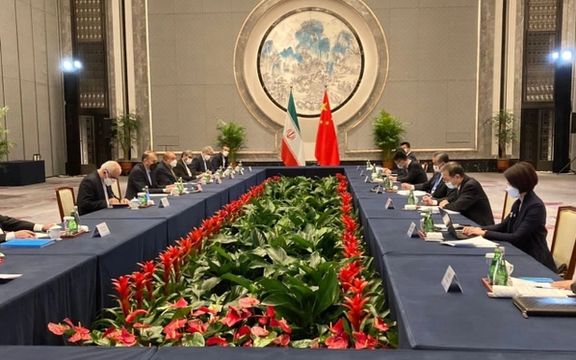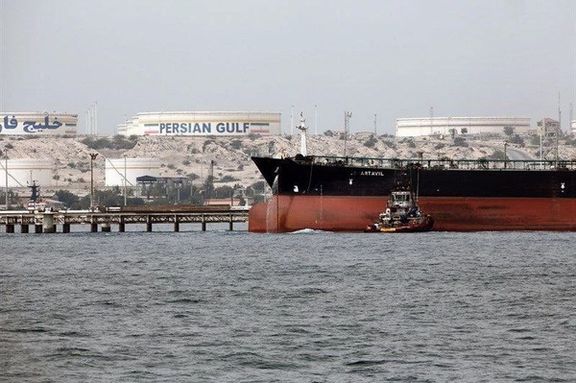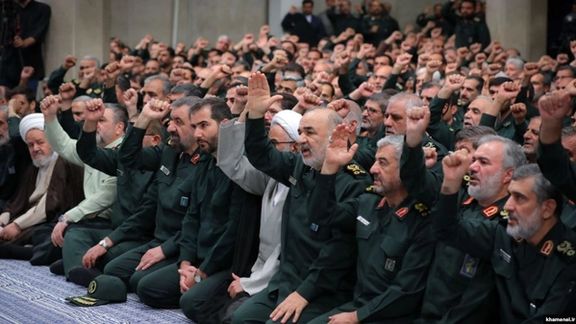Sanctioned Russian Tanker Carrying Iranian Oil Heading To Malaysia

A Russian-flagged ship targeted by US sanctions and suspected of carrying Iranian oil is heading to Malaysia, shipping data showed on Monday.

A Russian-flagged ship targeted by US sanctions and suspected of carrying Iranian oil is heading to Malaysia, shipping data showed on Monday.
The Linda, a crude oil tanker identified in a US Treasury document detailing sanctions against Russia, was in the Indian Ocean and was expected to arrive at Sungai Linggi port on Malaysia's west coast on Sunday, according to data from ship tracking website MarineTraffic.com.
It was not immediately clear whether authorities in Malaysia plan to allow the ship to anchor. Its marine department and foreign ministry did not respond to requests for comment.
US advocacy group United Against a Nuclear Iran (UANI), which monitors Iran-related tanker traffic through ship and satellite tracking, said Linda was transporting Iranian oil transferred from another ship at sea on Jan. 30.
The vessel had loaded crude oil from an Iranian port 10 days prior to conducting the transfer to Linda, UANI's chief of staff Claire Jungman told Reuters, citing satellite data.
The destination of the oil was not known but it could be transferred to another ship off Malaysian or Singapore waters, Jungman said.
Transferring illicit Iranian oil from one tanker to another has been taking place in Mlaysian waters.
According to the United States, Linda is owned by PSB Leasing, a unit of Russian lender Promsvyazbank, which has also been hit by international sanctions.
French authorities on Saturday seized another ship, Baltic Leader, that they said was owned by PSB Leasing.
Reporting by Reuters

China's has boosted Iranian oil imports to record levels in recent months, exceeding a 2017 peak before the US imposed sanctions, tanker tracking data confirms.
Higher imports by China comes amid talks between Tehran and world powers to revive a 2015 nuclear deal that will lift US sanctions on Iranian oil exports. The talks have intensified in recent weeks.
Iran International reported in February that China’s customs grossly underreported its oil imports from Iran.
When the United States imposed full sanctions on Iran’s oil exports in May 2019, China continued to buy 100,000-200,000 bpd until the third quarter of 2020. Before the US presidential elections, reports emerged that Iran was shipping more crude to China and the volume steadily increased, reaching the current levels.
Throughout last year, major American business publications such as The Wall Street Journal and Bloomberg were reporting that China had substantially increased its oil imports from Iran, which could undercut Washington’s leverage in the nuclear talks.
Analysts say the return of Iranian oil will ease tight global supplies and cool crude prices that have touched $100 a barrel following Russia's invasion of Ukraine. But Iran excess production capacity is limited as it is already exporting more than one million barrels per day.
Chinese imports exceeded 700,000 barrels per day (bpd) for January, according to estimates of three tanker trackers, surpassing the 623,000 bpd peak recorded by Chinese customs in 2017 before former US President Donald Trump reimposed sanctions in 2018 on Iranian oil exports.
One tracker estimated imports amounted to 780,000 bpd in November-December on average.
US President Joe Biden's administration has so far chosen not to enforce the sanctions against Chinese individuals and companies amid the negotiations on reviving the 2015 deal.
Record Chinese purchases of Iranian oil would mean less supply will be available to Tehran's previous buyers like Indian and European refiners should the sanctions be removed, traders said according to Reuters.
It would also mean that cheaper Iranian oil will continue to crowd out rival supplies from Brazil and West Africa, they said.
When asked for a comment by Reuters, China's foreign ministry declined to go into details but reiterated that Beijing opposes Washington's long-arm jurisdiction and urges Washington to remove unilateral sanctions.
Iranian officials have boasted in recent weeks that they have substantially increased oil export and defeated US policy of ‘maximum pressure’ imposed by former president Donald Trump.
A US State Department spokesperson said Washington is aware of China's Iranian oil purchases and has broached the subject with Beijing.
“China is an important trading partner for Iran, so, of course, our discussions with China on how best to get a mutual return to compliance with the JCPOA include discussions of sanctions enforcement," said the spokesperson, referring to the 2015 nuclear deal formally known as the Joint Comprehensive Plan of Action.
Demand From Teapots
At the forefront of China's buying are its independent refiners, or "teapots", who, traders said, are being enticed by the discounted prices, especially as their domestic refining margins got pinched under tight regulatory scrutiny.
"We're seeing more plants taking Iranian oil, because they are cheaper," a China-based executive involved in the business told Reuters, referring to the independent refiners.
Traders said January Iranian cargoes were transacted $5 a barrel below benchmark Brent LCOc1. Those prices were steady versus late 2021 but more attractive against competing supply from Brazil that was priced at $7 premium over Brent, they said.
Consulting firm Petro-Logistics, which tracks oil flows, said Iran's crude exports surged in December to over 1 million bpd, the highest level in almost three years.
"Iran's oil exports are mostly going to China, often through convoluted routes and transshipments, with small volumes going to Syria each month," said CEO Daniel Gerber.
Petro-Logistics sees total Iranian oil exports at close to 800,000 bpd in January and 700,000 bpd in February. But OilX, another data analytics firm, pegged Iranian exports at more than 1 million bpd for both January and February.
Iranian officials recently confirmed that they offer discounts to customers.
If the 2015 nuclear deal is revived, Iran is expected to divert sales away from the Chinese independent refiners, but the Islamic republic is unlikely to turn off the tap to these customers, source of more than $20 billion in revenue over the past two years.
"Iran may not have the full confidence how long the new deal could last. Chinese teapots have proven an essential outlet during the worst times and Iran would want to keep that channel open," said the China-based oil sector executive.
With reporting by Reuters

Iranian media and pundits say the newly found Chalous gas field in the Caspian Sea could not in time supply gas to Europe, if Russian shipments are sanctioned.
United States and European sanctions on Russia are far milder than against Iran, with oil and gas flowing to the West. While Russian gas exports to Europe via Ukraine continued normally Monday, financial sanctions on Russia and moving the Champions League soccer final have prompted some Iranian commentators to point out that Iran cannot move into the breach if Europe were to bar Russian gas.
Shargh newspaper wrote Monday that it would be wrong to overplay Iran's potential for replacing Russia in European markets. The reformist newspaper informed readers that Iran could not supply LNG (liquefied natural gas) given a lack of infrastructure – although Russian gas is supplied mainly by pipeline.
Iran needs foreign investment and technology to develop gas infrastructure, which has been difficult given years of international and United States sanctions. Iran and Russia hold 37 and 32 trillion cubic metres (tcm) of the world's proven gas reserves, while they respectively produce 250 and 638 billion cubic meters (bcm) of gas annually while respectively consuming 233 and 411 bcm domestically.
One of Tehran’s main aims is talks with world powers over restoring the 2015 nuclear deal - which US President Donald Trump withdrew from in 2018 – is to see lifted draconian US sanctions. Total, the French energy major withdrew from a contract in the South Pars gasfield in 2018due to the US ‘maximum pressure’ sanctions, a contract that included LNG development, which could be important for Tehran’s worldwide exports.
"The truth is we can't do anything in this regard unless we solve our problems with the rest of the world, which requires the restoration of the nuclear deal (JCPOA) and deepening of relations with developed countries," Morteza Behrouzi, energy expert, also told Hamshahri newspaper in September 28.
The Chalous Basin reportedly holds 30 percent of developable natural gas reserves of all Caspian Sea littoral countries and could, following $19 billion in investment and the lifting of US sanctions, be well placed to supply Europe.
Even before the recent Ukraine crisis, some argued Russia has over the years tried to prevent Iran from exporting gas to Europe.
"Russia will not allow Iran to enter the European gas markets that easily and will use every tool at their disposal to prevent Europe from overcoming its dependence on Russian gas," Alireza Soltani, political economist told Entekhab website February 16. "They will prevent [Iran from exporting gas to Europe] but even if it’s to happen, they want it to happen under Russian control."
Iranian officials have long been warning of inadequate natural gas production that cannot keep pace with domestic consumption. Energy consumption is relatively high because of state subsidies to consumers − costing $45 billion a year- that put gasoline, electricity and other fuels at low levels compared to other countries. Iran's oil minister Javad Owji said November that to avoid becoming a net importer, Iran needed $160 billion of investments in its oil and gas industries in the coming years.

After the Russian invasion of Ukraine began some analysts said oil can hit $130 a barrel and Iran's supplies will be needed, but prices pulled back on Friday.
Bloomberg quoted Rystad Energy Chief Executive Jarand Rystad as saying that the conflict could jeopardize one million barrels of crude that flows through Ukraine and the Black Sea, but “long-term disruptions could be far more significant.”
Adi Imsirovic, a Senior Research Fellow at the Oxford Institute for Energy Studies and former oil trader, said in a report published by Reuters that he is surprised the price has not jumped to $130 per barrel already. One reason could be that simmering tensions for the past months already contributed up to $10 a barrel to recent price increases.
But on Friday prices that had spiked above $100 a barrel retreated, signaling some reassurance that the West does not intent to sanction Russian energy supplies. Half of Russia’s crude oil exports, 2.3 million barrels a day go to the West.
Russia supplies ten percent of the world’s oil and is the second largest natural gas producer after the United States. Europe depends on Russia for close to 40 percent of its natural gas consumption.
President Joe Biden signaled on Thursday that he may release more supplies from strategic reserves in coordination with other countries, to address any shortfalls.
Analysts also raise the possibility of a nuclear agreement between Iran and the United States that could end Washington’s oil export sanctions on Tehran and help control prices. But Iran has little extra capacity, which is already not being utilized and exported. However, Imsirovic noted that Tehran has stockpiled 80 million barrels on tankers at sea that could be an immediate partial help.
An agreement between the US and Iran, however, remains uncertain as signals indicate Tehran insists on its tough conditions and US says “serious issues” remain unresolved. Statements by Iranian officials have not signaled of a softening of their position. Tehran still demands more US sanctions to be lifted and on Friday its nuclear chief said the country will continue to enrich uranium at 20 percent, even if sanctions are lifted.
It is not clear if Washington will make more concessions at this point, although the need to increase oil supplies looms large when the United States is confronting rising inflation.
Saudi Arabia and other Middle East producers could try to increase output too. Analysts are not sure whether low production by the Saudis is intentional or the result of technical limitations. The kingdom reduced output in 2020 when demand slumped with the pandemic. Some say that it is not easy to revive reduced production. But if Riyadh is holding back production that could also be related to Iran.
Saudi Arabia is not thrilled by the Biden Administration’s attempts to reach a nuclear deal with Iran, which many see as a weak arrangement that would not prevent Tehran from getting close to producing nuclear weapons. Many regional countries see the specter of a nuclear Iran as a serious threat to their security.
There is also the issue of Tehran’s support for Yemen’s Houthi rebels that fight a Saudi-led coalition that intervened in the country to support the internationally recognized government.

Commander of the Iran’s Revolutionary Guard’s Khatam al-Anbiya contracting arm says they received crude oil in exchange for government debts to its companies.
Brigadier General Hossein Housh-Sadat said on Wednesday that the Khatam-al Anbiya base will sell the crude through some “organizations that are legal” without elaborating on how the IRGC would sell the oil.
He said parts of the proceeds from the oil sales would be used to settle debts to contractors and some other parts will be allocated to new projects. The IRGC business conglomerate, with its flagship Khatam al-Anbiya “base” is the largest concern in the country, receiving many government contracts without competition.
Earlier in February, the spokesman of the parliament's budget review committee, Rahim Zare’, said the IRGC base will get 20 trillion rials ($80 million) worth of crude oil to finish construction projects for the country’s prayer grounds.
The administration of President Ebrahim Raisi is giving a lot of projects to different sections of the IRGC in return for crude oil that Tehran cannot sell due to sanctions, including a $3 billion project for rice production.
The government has announced that 4.5 billion euros worth of crude oil will be put at the disposal of the armed forces to sell. This means the lion’s share will go to the IRGC, which must find middlemen and illicit ways to export the oil, giving rise to corruption.

Iranian President Ebrahim Raisi told gas exporters in Qatar on Tuesday to avoid any "cruel" sanctions such as those imposed by the United States on Tehran.
Meanwhile, the spokesman of his government said any revival of Iran's 2015 nuclear accord with world powers must lift US sanctions.
"The members of this forum should not recognize those sanctions...(because) in today's world we see that the sanctions are not going to be effective," Raisi said in a gas exporters gathering.
Reuters reported last week that a US-Iranian deal is taking shape in Vienna after months of indirect talks to revive the nuclear pact abandoned in 2018 by then-US President Donald Trump, who also reimposed extensive sanctions on Iran.
"Any sanctions that ... deal a blow to Iran's economic benefits from the (nuclear) deal must be lifted," cabinet spokesman Ali Bahadori Jahromi told a news briefing carried live on a state-run website.
Since 2019, Tehran has gone well beyond the deal's limits, rebuilding stockpiles of enriched uranium, refining it to higher fissile purity and installing advanced centrifuges to speed up output.
Iran had demanded legal assurances that the United States will not exit the deal again, but Washington says it is impossible for US President Joe Biden to provide them.
A draft text of the agreement also alluded to other issues, including unfreezing billions of dollars in Iranian funds in South Korean banks, and the release of Western prisoners held in Iran.
Reporting by Reuters